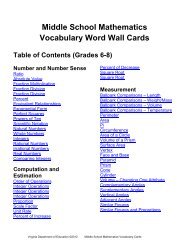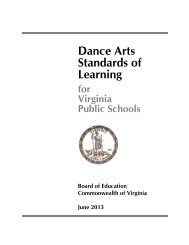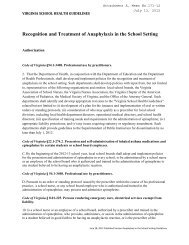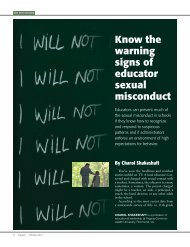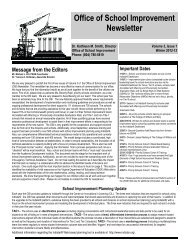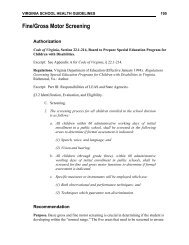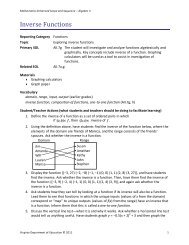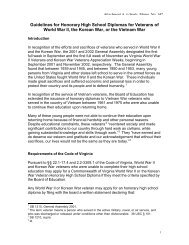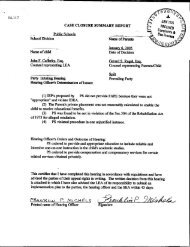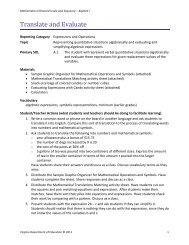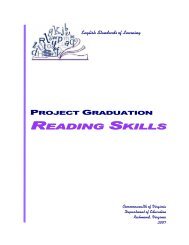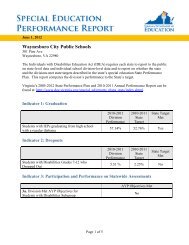What Makes Something Alive - Virginia Department of Education
What Makes Something Alive - Virginia Department of Education
What Makes Something Alive - Virginia Department of Education
Create successful ePaper yourself
Turn your PDF publications into a flip-book with our unique Google optimized e-Paper software.
Topic 3: Session 3.4 – Talking with a Habitat Scientist<br />
Session Supplies:<br />
• Class Habitat Statement – from Topic 3, Session 3.1<br />
• Teacher-selected book about a scientist who studies animals and their habitats (nonfiction)<br />
• Talking with a Habitat Scientist sheet (pg. 76)<br />
• <strong>What</strong> Do We Know About Habitats sheet – from Topic 3, Session 3.1 (pg. 67)<br />
• <strong>Virginia</strong> Animals and their Habitats Project Design Brief (pg. 77-78 or pg. 235-236)<br />
• Habitat Research Planning sheet (pg. 79 or pg. 238)<br />
• Team notebooks – can be actual three-ring binders or can be student-made binders<br />
Session <strong>Virginia</strong> SOL<br />
Science English Mathematics History & Social Science<br />
2.7 d, e<br />
2.12 b<br />
2.9<br />
2.10<br />
2.12<br />
2.1 a, b, c, i, j, k<br />
2.5 a, b, c<br />
2.8 b, c<br />
Session 3.4 – Talking with a Habitat Scientist<br />
Teacher Questions & Notes<br />
Prior to reading:<br />
- <strong>What</strong> kind <strong>of</strong> book is this? (fiction or<br />
nonfiction)<br />
-How do you know?<br />
-<strong>What</strong> do you think we will learn from<br />
it?<br />
After reading:<br />
-<strong>What</strong> is a habitat? (Be sure the<br />
students have included that it is where<br />
animals have the food, water, shelter<br />
and space that is needed to survive, or<br />
where a plant has the proper soil<br />
conditions, sunlight, temperature and<br />
water to thrive.)<br />
Procedures<br />
1. Review the Class Habitat Statement written previously with the<br />
students. Review the previous activity where students were<br />
scientists observing a habitat.<br />
2. Read the teacher-selected book about a scientist who studies<br />
animals and their habitats. Discuss any new vocabulary as you<br />
read, especially the words that directly pertain to habitats and<br />
animals.<br />
3. Review the Class Habitat Statement again. Ask if it needs to be<br />
revised. Make any necessary revisions.<br />
4. Have the students copy the Class Habitat Statement in their<br />
journals. Then have them write at least three questions that they<br />
would like to ask a habitat scientist on the Talking with a Habitat<br />
Scientist sheet (pg. 76).<br />
NOTE: You may consider inviting someone from the <strong>Virginia</strong><br />
<strong>Department</strong> <strong>of</strong> Game and Inland Fisheries, or someone from your<br />
local Forestry <strong>Department</strong> to visit your classroom and speak to your<br />
students.<br />
74<br />
<strong>Virginia</strong> Animals and their Habitats<br />
Topic3



